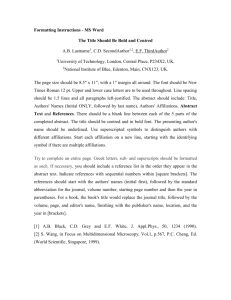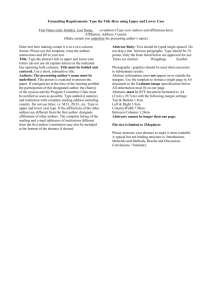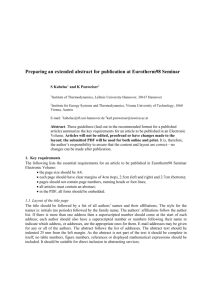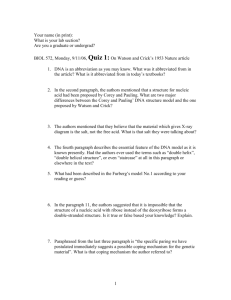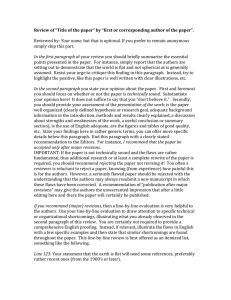Journal Manuscript Template: Allelochemical Interactions
advertisement
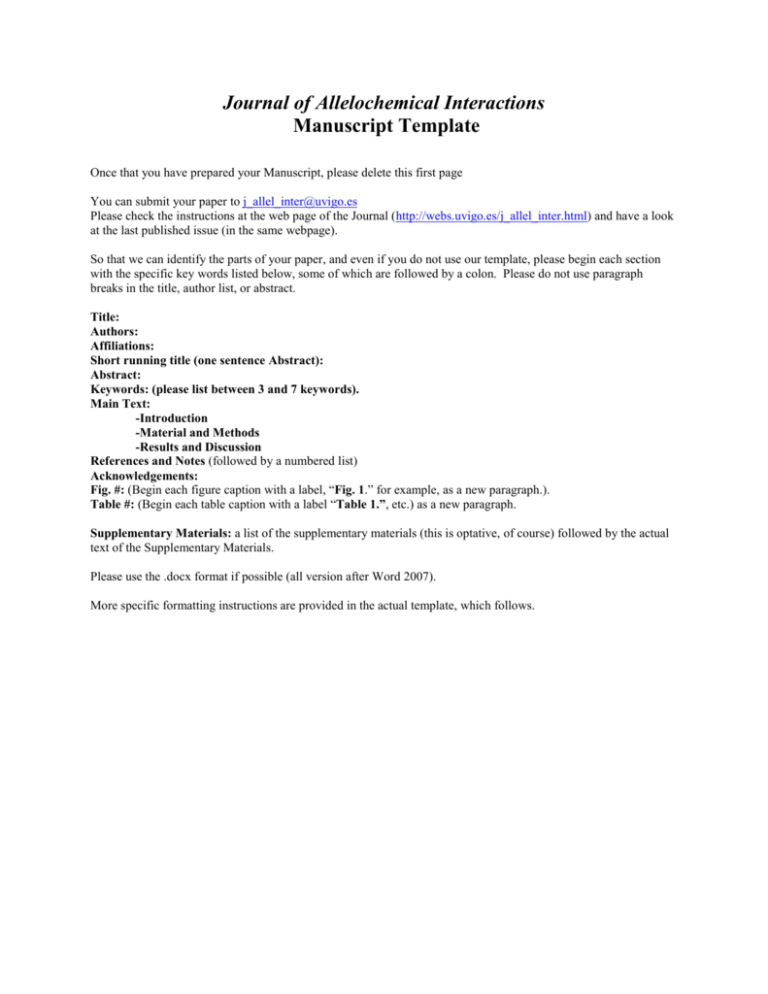
Journal of Allelochemical Interactions Manuscript Template Once that you have prepared your Manuscript, please delete this first page You can submit your paper to j_allel_inter@uvigo.es Please check the instructions at the web page of the Journal (http://webs.uvigo.es/j_allel_inter.html) and have a look at the last published issue (in the same webpage). So that we can identify the parts of your paper, and even if you do not use our template, please begin each section with the specific key words listed below, some of which are followed by a colon. Please do not use paragraph breaks in the title, author list, or abstract. Title: Authors: Affiliations: Short running title (one sentence Abstract): Abstract: Keywords: (please list between 3 and 7 keywords). Main Text: -Introduction -Material and Methods -Results and Discussion References and Notes (followed by a numbered list) Acknowledgements: Fig. #: (Begin each figure caption with a label, “Fig. 1.” for example, as a new paragraph.). Table #: (Begin each table caption with a label “Table 1.”, etc.) as a new paragraph. Supplementary Materials: a list of the supplementary materials (this is optative, of course) followed by the actual text of the Supplementary Materials. Please use the .docx format if possible (all version after Word 2007). More specific formatting instructions are provided in the actual template, which follows. Title: Please substitute this paragraph with the real title Authors: The author list should be one single paragraph. Authors should be listed by first name (complete) followed by last name and separated by commas. Use superscript numbers to link affiliations, and symbols *†‡ for author notes. For example, John Smith1*, Manuel González1,2 Affiliations: 1 Affiliations should be preceded by superscript numbers corresponding to the author list, and each affiliation should end with a period. 2 Each affiliation should be a separate paragraph. *Correspondence to: include the email addresses of the corresponding author(s). Please use the asterisk (*) symbol for the corresponding author information. If possible, please include the email addresses of all the authors, even if there is only one corresponding author. †Additional author notes should be indicated with symbols (for example, for current addresses). Abstract: The abstract should be a short description of the rationale and objectives of the paper, an introductory part about the state-of-the art, the main achievements and a final paragraph about the relevance to the field. Running title: Please summarize the title in less than 60 characters (including spaces). Introduction: this should include: 1) The state of the art in the field related to the preformed experiments 2) The objetives of the study and the rationale Material and Methods: you can include both in the same section or, if adequate, you can split this part in two. Results and Discussion: Discussion is pivotal, please split this part if you feel that it will be better in order to have a strong discussion of the achievements Figures and Tables should be cited in order, including those in the supporting online material (which should be cited as, for example, figure S1, and table S1). You can include page breaks if you would like to place the figures within the text. Subheads. You can use subheads in any part of the Manuscript if they improve readability. References should be cited in parentheses (author, year). If more than two authors are referred, please use “et al.” in italics. References should be separated by commas and ordered by year. Literature 1. Please provide a unique list of references, following alphabetical order of authors, and then chronological. Please provide all the information (Authors, year, title, Journal (of book), issue, pages, doi). Please check the actual issue of the Journal in order to follow the style Acknowledgments: Please include funding information such as grant numbers and funding agencies. You can also include a statement of author contributions here and you can acknowledge any received help, from language improving to revision of the paper or technical participation. Fig. 1. The figure caption should begin with an overall descriptive statement of the figure followed by additional text. They should be immediately after each figure. Figure parts are indicated with capital letters (A). If you prefer, you can place both the actual figures and captions logically through the text near where they are cited rather than at the end of the file (but not both). If a paragraph in the main text begins with the name of a figure, write out “Figure” in full. Fig. 2. You can place graphics above each equation as part of this file. Table 1. Start this caption with a short description of your table. Format tables using the Word Table commands and structures. Supplementary Materials: optional, it can include any of the following items: Figures S1-S# Tables S1-S# Movies S1-S# Audio Files S1-S# External Databases S1-S# References (##-##)


